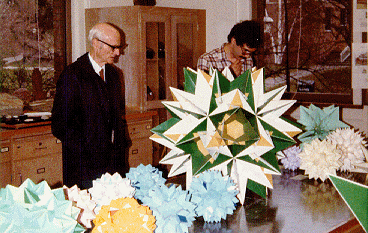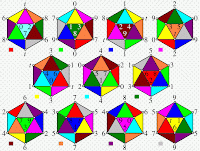One of these times, I'll post a picture gallery of some of my mobiles. Although Calder is a favorite artist of mine, I don't make mobiles in the abstract way he made famous. As a lover of geometry, I make them very regular. I even have a spreadsheet with formulas for working out the length ratios for various kinds. For example, sometimes I use Fibonacci ratios for the lengthening support wires, sometimes a more pure geometric sequence. They also represent fractals, with a dimension in the range 1.4-1.7.
My favorite, which hangs in my office, is made with skeletal polyhedra. All the 5 "regular solids", of course, plus four other mixed-face shapes. Now, I find myself wondering why I never learned before of the king of polyhedra, Donald Coxeter. The recent biography, "King of Infinite Space: Donald Coxeter, the Man Who Saved Geometry" by Siobhan Roberts, is shelved as a math book, but clearly belongs in the BIOG section of the library.
HSM Coxeter ("Donald" is from his third name, MacDonald) lived nearly the entire 20th Century, and three years into the 21st. By the time he was seventy, people that met him were astonished that this legend still lived. By the time he was 95, their children or grandchildren shared the experience. He lived 96 years, and just two days before he died, he put the finishing touches on his last monograph, titled "An Absolute Property of Four Mutually Tangent Circles," a breakthrough paper published in 2005.
Not for him, the usual "burn out young" mathematical career. He was productive for some eighty years...phenomenally productive. A classical geometer in an age of "new math" and "down with triangles", he is solely responsible for the resurgence of geometry that has revivified math, cosmology and physics since the 1970s. It is to "Coxeter groups" that we owe the efficiency of modems, and his masterwork "Regular Polytopes", published in 1948, underlies recent theories of the "shape" of the Universe.
 What is a polytope? It is a generalization of a polyhedron into more than three dimensions. This image shows Coxeter with George W. Hart at a conference at which many polyhedral models, most inspired by his work, were displayed. A plane figure is a polygon (gon = side); a 3-D shape made of several or many polygons is a polyhedron (hedron = face). The suffix tope means place.
What is a polytope? It is a generalization of a polyhedron into more than three dimensions. This image shows Coxeter with George W. Hart at a conference at which many polyhedral models, most inspired by his work, were displayed. A plane figure is a polygon (gon = side); a 3-D shape made of several or many polygons is a polyhedron (hedron = face). The suffix tope means place.The five "regular solids" are the Tetrahedron, composed of four equilateral triangles, the Cube or Hexahedron, composed of six squares, the Octahedron, composed of eight equilateral triangles, the Dodecahedron, composed of twelve pentagons, and the Icosahedron, composed of twenty equilateral triangles.
 This figure shows one way to represent a 4-D polytope called the 11-cell. It is a regular polytope whose eleven topes or cells are icosahedra. The colored square next to each of the eleven shapes shows which face it attaches to on the other ten, and the numbering is used to indicate orientation. You gotta think in four dimensions to figure it out, which I can't do. Click for a large view.
This figure shows one way to represent a 4-D polytope called the 11-cell. It is a regular polytope whose eleven topes or cells are icosahedra. The colored square next to each of the eleven shapes shows which face it attaches to on the other ten, and the numbering is used to indicate orientation. You gotta think in four dimensions to figure it out, which I can't do. Click for a large view.Somehow, Coxeter and others can think in almost any number of dimensions, and get useful results. His "Coxeter graphs" are a compact notation of the symmetry of a kaleidoscope in any number of dimensions, that would show some regular polytope (I'm really getting to the limit of my understanding here...).
 The one called "The Coxeter Graph", however, as shown here in four different arrangements, has a use I really don't comprehend, but was a discovery that tickled him so much that he wrote of it under the title "My Graph".
The one called "The Coxeter Graph", however, as shown here in four different arrangements, has a use I really don't comprehend, but was a discovery that tickled him so much that he wrote of it under the title "My Graph".Though I have mentioned a few uses of his work, he didn't care much for its usefulness. He was the epitome of a pure mathematician, and sometimes retorted rather sharply when a practical application of his work was described.
Although he was typically cordial, even affable, he bore fools not at all, and reading between the lines of the text, one finds that he could be a bit of a jerk. Or perhaps that term is too harsh. Perhaps he is more like a colleague of mine, who tends to roam the halls when thinking hard. He'll run right over you if you don't step quickly; he simply doesn't see you. Coxeter's geometric vision was vastly wide, but in the rest of life, his tunnel vision was legendary.
These scattered reflections sadly belie the quite comprehensive narrative that Ms Roberts has produced. A biography of Coxeter has been long overdue, and I am grateful to make his posthumous acquaintance.



No comments:
Post a Comment